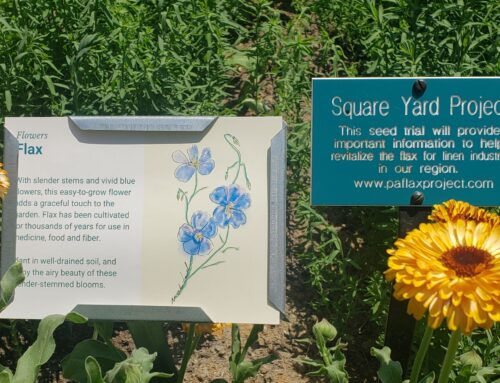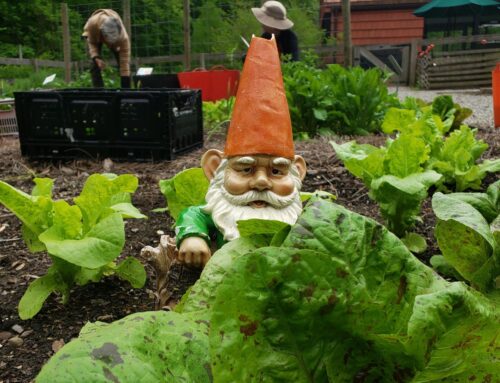Recipes from Lucille’s Garden: Spring 2024 Edition
The weather is warming up, and Lucille’s Garden has already produced a variety of lettuces and leafy greens. (Check out a complete list of what we harvested on a recent week in May here.) In terms of eating this spring harvest, your first thought might be salad, but there are other ways to enjoy the abundance. Don’t worry, though; I do have salad tips to share also.
Sandwiches
Arugula is my favorite for this. Add it to a BLT (or a Tempeh Tomato Lettuce Avocado sandwich if you don’t eat meat) for a delightful switch-up. The juicy sweetness of the tomatoes in the sandwich, plus the saltiness and smoky, savory taste of the bacon (or smoked tofu/tempeh), and the peppery taste from the arugula kicks this classic combo up a notch.
Soup
Any of the kale varieties we harvested will be great in soup. I have a favorite kale, carrot & chickpea soup that I enjoy making, but feel free to add it to any of your family favorites!
Braised
Kale, collard greens and Swiss chard are excellent for this. (Note: Swiss chard stems can be eaten if cut thin. It also looks pretty.) My grandmother used a smoked turkey leg when cooking collard greens for flavor, and my uncle uses bacon. Ham and liquid smoke work well also. Collard greens are also good in soups as well as salad.
Pasta
Broccoli raab is great in pasta. I first tried it in a penne pasta dish that had a cream sauce, like Alfredo. Use any pasta that you like and have on hand. Now that I think of it, this could also be fetching in a pasta carbonara. I might have to try it and see what I think! No matter what pasta you use, add some oregano. We are harvesting ours here and it smells delicious.
Stir Fry or Fried Rice
Bring takeout back home by adding the aforementioned broccoli, bok choi, and parade bunching onion to your favorite stir fry dishes. If you’re like me and didn’t know what parade bunching onion was, they’re green onions or scallions. These are often used in Asian cooking, and can be added in or used as a garnish. When making a stir-fry sauce, garlic and soy sauce make a good base. From there, feel free to add: ginger, black vinegar, oyster sauce (mushroom sauce for vegetarian and vegan friends). If you like heat and are feeling adventurous, I recommend chili oil, dried chiles, Sriracha and Szechuan peppercorns.
Lettuce Wraps
I enjoy a good lettuce wrap or two … or three. They’re cheap and easy to make, which makes them great appetizers and snacks. Add any filling you wish into a leaf, roll it or fold it like a taco shell, and dig in! You can also fold the lettuce like a parcel depending on its size.
Bread
If you enjoy baking bread or are considering getting started, focaccia is easy to make and often includes herbs. You can add herbs to any bread that you like. Just fold them into the dough or sprinkle them on top with some olive oil. You can also chop your favorites up and add them to oil for dipping.
Salad Tips
I did promise salad tips, and I haven’t forgotten! Here are my tips for making a salad satisfying and interesting to eat.
- Taste the lettuce. When I was in cooking school, we had a class on lettuce varieties. We were encouraged to taste the plain lettuce leaf. Knowing what the leaf tastes like helps me figure out what flavors will best complement its flavor.
- Mix textures. Salad can get boring if it is all crispy, or worse, wilted. Adding different things to the salad will make it more interesting. Nuts, tortilla strips, or croutons add crunch. Avocado or cheese will give a creamy mouth feel. Adding protein will add something chewy and make you feel full. Play around with this a bit and see what combinations you create!
- Use infused vinegar or oil made with your fresh harvested herbs. I’ve made sage-infused vinegar in the past, and rosemary oil is one of my favorites (try the latter on popcorn and thank me later). You can use any herb to infuse oil or vinegar, which you can then use as a base for vinaigrettes.
- Season your greens. A chef once said in my salad class, “I don’t know about you, but my greens don’t come seasoned.” I never forgot this advice. If you’ve never seasoned your greens, definitely try it. The gospel of salt and pepper hasn’t failed me yet.
- Mix flavors. Play around with adding pickled vegetables, salty, sweet, and savory elements to the salad to make it more interesting.
- If using kale in a salad, massage it first. Your digestive system will thank me. A little lemon juice (or a splash of your chosen vinaigrette will do), and give it a good massage.
- Add fresh herbs to the salad. It didn’t occur to me to add herbs to a salad just like I would to an entree for flavoring. Depending on the salad, I recommend mint. Mint is refreshing, but use sparingly; a little mint goes a long way. Any herb will be great in a salad. Fennel fronds would be delicious too.
- Bulk it up. You have a lot of options when adding something to a salad to help you feel full. Some ideas are: beans, legumes, tofu, tempeh, chicken, steak, fish and shellfish. Potatoes are also great in a salad. Honestly, potatoes are great in and with everything. Let me digress before I go down a potato rabbit hole.
BONUS TIP: Grill the lettuce. I tried this once when I saw it on Food Network. I recommend trying this with a head of lettuce so it doesn’t fall apart. Just place it on the grill for a few seconds, which is long enough to get grill marks, and a slightly smoky flavor. Once you remove it from the heat, chop and use in your salad as usual.
Above all, have fun, both in the garden and with the food you harvest and cook. Invite your friends and family over too – everything tastes better when it’s shared. Let us know if you try any of these recipes at home or if you have favorite ways to enjoy these foods. I’d love to hear from you at info@tylerarborteum.org.






